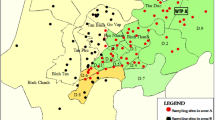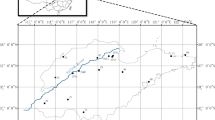Abstract
Trihalomethanes (THMs) are the most abundant disinfection byproducts (DBPs) of the chlorination disinfection. THMs speciation and their geospatial distribution were examined in 58 locations throughout the water distribution network of Karachi city. THMs (CHCl3, CHCl2Br, CHClBr2 and CHBr3) and physico-chemical parameters (pH, TDS, DO, Residual chlorine, temperature and TOC) were determined. CHCl3 was the major THM found in all water samples of 58 locations, which accounted for 91.69 % of the total THMS followed by CHCl2Br (5.69 %), CHClBr2 (1.78 %) and CHBr3 (0.85 %). Total THMs level exceed the maximum contamination level of WHO and USEPA at some locations. Varying nature of correlation from high to low was found within THMs and among the physico-chemical parameters. GIS linked geospatial analysis revealed the association of THMs level with demographical and geological based variations from east to west of Karachi city. Continuous monitoring program and legislation for the contaminant levels were suggested to avoid adverse public health impact of THMs in drinking water supplies.




Similar content being viewed by others
References
Abdullaha MP, Yewa CH, Ramli MS (2003) Formation, modeling and validation of trihalomethanes (THM) in Malaysian drinking water: a case study in the districts of Tampin, Negeri Sembilan and Sabak Bernam, Selangor, Malaysia. Water Res 37:4637–4644
APHA (1992) Standard methods for the examination of water and wastewater. 18th edn. American Public Health Association, Washington.DC
Becher G (1999) Drinking water chlorination and health. Acta Hydrochem Hydrobiol 27:100–102
Beller TA, Lichtenberg JJ, Kroner RC (1974) The occurrence of organohalides in chlorinated drinking water. J Am Water Works Assoc 66:703–712
Briggs DJ, Briggs CS, Elliott P, Fischer P, Kingham S, Lebret E, Pryl K, Reeuwijk HV, Smallbone K, Der Veen AV (1997) Mapping urban air pollution using GIS: a regression-based approach. Int J Geogr Inform Sci 11:699–718
Bull RJ, Birnbaum L, Cantor KP, Rose JB, Butterworth BE, Pegram R, Tuomisto J (1995) Water chlorination: essential process or cancer hazard? Toxicol Sci 28(2):155–166
Canada Health (2010) Guidelines for canadian drinking water quality. FPT Committee on Health and Environment, Ottawa, Ontario
Chang EE, Lin YP, Chiang PC (2001) Effects of bromide on the formation of THMs and HAAs. Chemosphere 43:1029–1034
Christman RF, Kronkerg L, Sing R, Ball L, Johnson JD (1990) Identification and mutagenic byproducts from aquatic humic chlorination. AWWARF, and AWWA, Denver, CO
EU- European Union (1998) Council Directive 98/83/EC. Quality of water intended for human consumption, 3 (1998) Off J Eur. Communities 41(330):32–54
Golfinopoulos SK, Nikolaoub AD (2004) Survey of disinfection by-products in drinking water in Athens, Greece. Desalination 176:13–24
Golfinopoulos SK, Nikolaou AD, Lekkas TD (2003) The occurrence of disinfection by-products in the drinking water of Athens, Greece. Environ Sci Pollut Res Int 10:368–372
Jerrett M, Burnett RT, Kanaroglou P, Eyles J, Finkelstein N, Giovis C, Brook JR (2001) A GIS - environmental justice analysis of particulate air pollution in Hamilton, Canada. Environ Plan A 33:955–973
Kampioti A, Stephanou E (1999) Simultaneous determination of halogenated neutral and acidic disinfection byproducts in drinking water by closed-loop striping extraction and capillary gas chromatography. J Chromatogr A 857:217–229
Karamouz M, Zahraie B, Kerachian R, Mahjouri N, Moridi A (2006) Development of a master plan for industrial solid waste management. Int J Environ Sci Tech 3:229–242
Krasner SW (1999) Chemistry of disinfection by-product formation. In: Singer PC (ed) Formation and control of disinfection by-products in drinking water. AWWA, Denver
Krasner SW, Sclimenti MJ, Means EG (1994) Quality degradation: implications for DBP formation. J Am Water Works Assoc 86:34–47
KWSB (2011) Quality assurance. http://www.kwsb.gos.pk/View.aspx?Page=27. Accessed 13 December 2011
Li A, Zhao X, Liu H, Qu J (2011) Characteristic transformation of humic acid during photoelectrocatalysis process and its subsequent disinfection by-product formation potential. Water Res 45:6131–6140
Liua S, Zhu Z, Qiu Y, Zhao J (2011) Effect of ferric and bromide ions on the formation and speciation of disinfection by-products during chlorination. J Environ Sci 23:765–772
NHMRC and NRMMC (2004) Australian Drinking Water Guidelines 2004. National Water Quality Management Strategy, Canberra
Nikolaou A, Kostopoulou M, Lekkas T (1999) Organic by-products of drinking water chlorination. Glob Nest 1:143–156
Nikolaou A, Lekkas T, Golfinopoulos S, Kostopoulou M (2002) Application of different analytical methods for determination of volatile chlorination by-products in drinking water. Talanta 56:717–726
Pieterse MJ (1988) The potential health risk of trihalomethanes in drinking water: a perspective. S Afr J Sci 84:166–170
Richardson SD, Plewa MJ, Wagner ED, Schoeny R, DeMarini DM (2007) Occurrence, genotoxicity, and carcinogenicity of regulated and emerging disinfection by-products in drinking water: a review and roadmap for research. Mutat Res 636:178–242
Rodriguez MJ, Sérodesb JB (2001) Spatial and temporal evolution of trihalomethanes in three water distribution systems. Water Res 35:1572–1586
Rook JJ (1974) Formation of haloforms during chlorination of natural waters. Water Treat Exam 23:234–243
Simpson KL, Hayes KP (1998) Drinking water disinfection by-products: an Australian perspective. Water Res 32:1522–1528
Singer P (1994) Control of disinfection by-products in drinking water. J Env Eng 120:727–744
Tabesh M, Delkhah A, Delavar MR (2010) Use of geographic information system based tool for renovation and rehabilitation of water distribution systems. Int J Environ Sci Tech 7:47–58
USEPA (1998) Method 551.1-1. Determination of chlorination disinfection byproducts, chlorinated solvents, and halogenated pesticides/herbicides in drinking water by liquid–liquid extraction and gas chromatography with electron-capture detection. National Exposure Research Laboratory, Office of Research and Development, USEPAS, Cincinnati
USEPA (1998b) Stage1 disinfectants and disinfection by-products rule (Stage1 DBPR). Fed Reg 63:69390–69476
USEPA (2001) Controlling disinfection by-products and microbial contaminants in drinking water. EPA. 600-R-01-110. US. Environmental Protection Agency, Pennsylvania
USEPA (2006) Initial distribution system evaluation guidance manual for the final stage 2 disinfectants and disinfection byproducts rule. 815-B-06-002, EPA, Washington
Uyak V, Toroz I, Meric S (2005) Monitoring and modelling of trihalomethanes (THMs) for a water treatment plant in Istanbul. Desalination 176:91–101
Wang GS, Huang PL (2006) The roles of bromide and precursor structures on DBP formation and species distribution. Water Sci Technol 6:27–33
Wei J, Ye B, Wang W, Yang L, Tao J, Hang Z (2010) Spatial and temporal evaluations of disinfection by-products in drinking water distribution systems in Beijing, China. Sci Total Environ 408:4600–4606
WHO (2011) Guidelines for drinking-water quality, 4th edn. World Health Organization, Geneva
Zerrouqi Z, Sbaa M, Oujidi M, Elkharmouz M, Bengamra S, Zerrouqi A (2008) Assessment of cement’s dust impact on the soil using principal component analysis and GIS. Int J Environ Sci Tech 5:125–134
Zhai X, Liu J, Liu F, Guo Y (2010) Trihalomethane formation of source water contaminated by seawater intrusion. 2010 International Conference on Environmental Science and Information Application Technology (ESIAT) 3:565–568. doi:10.1109/ESIAT.2010.5568966
Acknowledgments
The authors gratefully acknowledge the Higher Education Commission of Pakistan (HEC) for providing funding and support for this study through the scheme National Research Program for Universities (No. 20-613/R&D/06/755).
Author information
Authors and Affiliations
Corresponding author
Rights and permissions
About this article
Cite this article
Siddique, A., Saied, S., Zahir, E. et al. Speciation and geospatial analysis of disinfection byproducts in urban drinking water. Int. J. Environ. Sci. Technol. 11, 739–746 (2014). https://doi.org/10.1007/s13762-013-0277-1
Received:
Revised:
Accepted:
Published:
Issue Date:
DOI: https://doi.org/10.1007/s13762-013-0277-1




